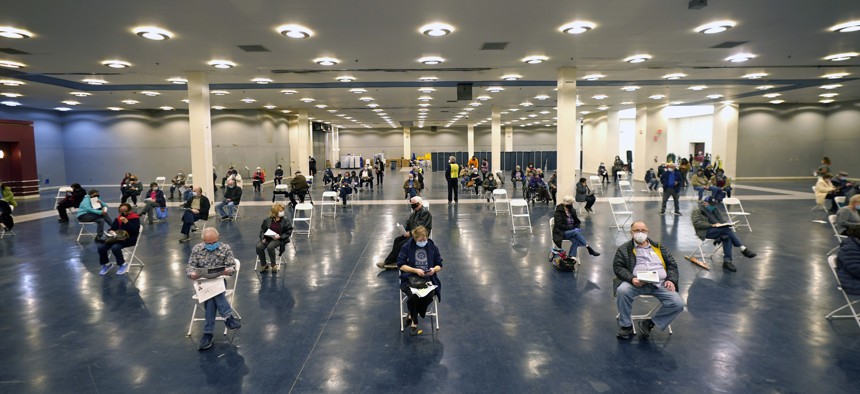How Two Local Governments Got Covid Vaccination Registrations Right

In this Jan. 20, 2021 people that received a COVID-19 vaccine socially distance as they wait the required fifteen minutes to monitor for adverse reactions after getting the shot at the Dallas County mass vaccination site at Fair Park in Dallas. AP Photo/LM Otero
From system failures to overbooked appointments, the technology many governments relied on to manage vaccinations crashed and burned. But New Orleans and Dallas County found software that worked.
When New Orleans needed a website for Covid-19 vaccine sign-ups and appointment scheduling, officials turned to a technology platform well known in the community: the 311 system.
Other cities and states have struggled with vaccine management websites that collapsed under the high volume of registrations or allowed appointment links to be shared beyond intended recipients, leading to overbooked appointments. But New Orleans found its 311 call center platform, Quickbase, could be adapted to accept vaccine registrations and efficiently schedule appointments.
“It’s a tool we are very familiar with and we knew it would meet our immediate needs,” said Tyrell Morris, executive director of the Orleans Parish Communication District, which oversees the city’s 311 and 911 call centers.
Through the system, users can enter eligibility information (Louisiana has since opened up vaccine availability to all residents over age 16) and register for an appointment if one is available. If appointments are not available, the city can later send registration links to residents based on factors such as ZIP code in order to target areas with low vaccination rates or high infection rates, Morris said.
Because the vaccine management system is integrated with the 311 system, New Orleans was also able to use it as a hotline that residents could call to make vaccine appointments. That meant call volume to 311 increased, but Morris said the city was rolling out a new artificial intelligence chatbot to automate some generic service requests so the appointment requests would not tie up the call center.
Other cities haven’t been as lucky.
“We’ve seen a lot of areas where projects have really struggled to get up and running successfully,” said Jay Jamison, the chief product and technology officer at Quickbase.
Two widely used vaccine management programs that launched at the outset of the pandemic have proven problematic for state and local governments across the country, leading some health officials to hunt for better technology. The officials complained that the VAMS system, backed by the Centers for Disease Control and Prevention, was plagued with functionality issues that made it difficult to use. And PrepMod, developed by the Maryland Partnership for Prevention, allowed vaccine appointment links to be shared outside the intended group of recipients.
Dallas County, Texas switched vaccine management software about a month after it began inoculating residents because its first system required too much physical paperwork to record and track vaccinations.
“For the first four weeks, we were doing it all paper-based. It was so labor intensive,” said Dr. Phil Huang, director of Dallas County’s Department of Health and Human Services.
The county now uses a paperless vaccine management software created by Luminare, a Houston-based health tech company. Through the system, Dallas County officials can track all registrations, assign recipients to vaccination sites for appointments, collect data on the doses administered, and report immunization data to the state.
The system has been instrumental in helping the county keep up with demand, Huang said. The county had administered more than 295,000 doses of the vaccine as of April 8.
Perhaps most helpful is the system’s ability to prioritize vaccination groups and then select people who preregistered for the vaccine from those groups and send them invitations to make appointments, Huang said.
The software hasn’t been completely without issues—Huang said there were some minor issues with vaccine appointment links being shared. But he added Luminare has worked with the county to address any problems that came up and that he talks with the company’s CEO, Sarma Velamuri, multiple times a day.
“Overall, we are getting almost 10,000 people a day through the system so it is working pretty well,” Huang said.
Andrea Noble is a staff correspondent for Route Fifty.
NEXT STORY: In the Rush to Digital, Governments Can’t Leave Behind Cash Payers





